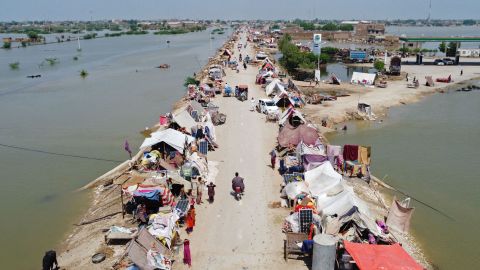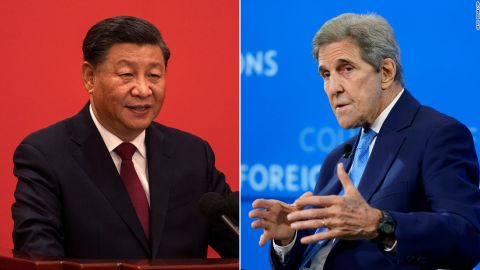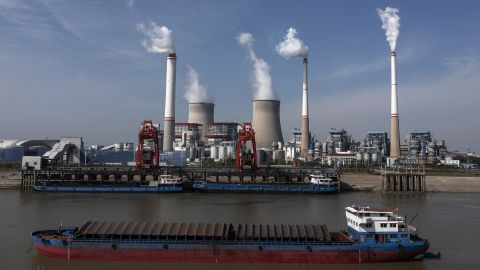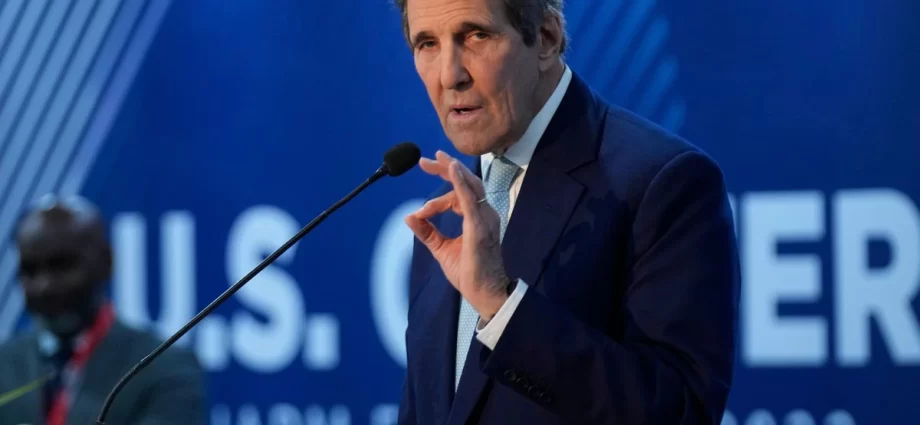As global leaders converge in Sharm el-Sheikh, Egypt, for the UN’s annual climate summit, researchers, advocates and the United Nations itself are warning the world is still wildly off-track on its goal to halt global warming and prevent the worst consequences of the climate crisis.
Over the next two weeks, negotiators from nearly 200 countries will prod each other at COP27 to raise their clean energy ambitions, as average global temperature has already climbed 1.2 degrees Celsius since the industrial revolution.
They will haggle over ending the use of coal, the dirtiest fossil fuel, which has seen a resurgence in some countries amid the war in Ukraine, and try to come up with a system to funnel money to help the world’s poorest nations recover from devastating climate disasters.
But a flood of recent reports have made clear leaders are running out of time to implement the vast energy overhaul needed to keep the temperature from exceeding 1.5 degrees Celsius, the threshold scientists have warned the planet must stay under.
Reports from the United Nations and the World Meteorological Association show carbon and methane emissions hit record levels in 2021, and the plans countries have submitted to slash those emissions are beyond insufficient. Given countries’ current promises, Earth’s temperature will climb to between 2.1 and 2.9 degrees Celsius by 2100.
Ultimately, the world needs to cut its fossil fuel emissions nearly in half by 2030 to avoid 1.5 degrees, a daunting prospect for economies still very much beholden to oil, natural gas and coal.
“No country has a right to be delinquent,” US Climate Envoy John Kerry told reporters in October. “The scientists tell us that what is happening now – the increased extreme heat, extreme weather, the fires, the floods, the warming of the ocean, the melting of the ice, the extraordinary way in which life is being affected badly by the climate crisis – is going to get worse unless we address this crisis in a unified, forward-leaning way.”
Here are the top issues to follow at COP27 in Egypt.
A fight over ‘loss and damage’

Developing and developed countries have for years tussled over the concept of a “loss and damage” fund; the idea which suggests countries causing the most harm with their outrageous planet-warming emissions should pay poorer countries, which have suffered from the resulting climate disasters.
It has been a thorny issue because the richest countries, including the US, don’t want to appear culpable or legally liable to other nations for harm. Kerry, for instance, has tiptoed around the issue, saying the US supports formal talks, but he has not given any indication of what solution the country would sign on to.
Meanwhile, small island nations and others in the Global South are shouldering the impact of the climate crisis, as devastating floods, intensifying storms and record-breaking heat waves wreak havoc.
The deadly flooding in Pakistan this summer, which killed more than 1,500 people, will surely be an example the countries’ negotiators point to. And since September, more than two million people in Nigeria have been affected by the worst flooding there in a decade. At this very moment, Nigerians are drinking, cooking with and bathing in dirty flood water amid serious concerns over waterborne diseases.
Loss and damage will have space on the official COP27 agenda this year. But beyond countries committing to meet and talk about what a potential loss and damage fund would look like, or whether one should even exist, it is unclear what action will come out of this year’s summit.
“Do we expect that we’ll have a fund by the end of the two weeks? I hope, I would love to – but we’ll see how parties deliver on that,” Egypt’s chief climate negotiator Ambassador Mohamed Nasr recently told reporters.
Former White House National Climate Adviser Gina McCarthy told CNN she thinks loss and damage will be the top issue at the UN climate summit this year, and said nations including the US will face some tough questions about their plans to help developing nations already being hit hard by climate disasters.
“It just keeps getting pushed out,” McCarthy said. “There’s need for some real accountability and some specific commitments in the short-term.”
A tense US-China relationship

People will be watching to see if the US and China can repair a broken relationship at the summit, a year after the two countries surprised the world by announcing they would work together on climate change.
The newfound cooperation came crashing down this summer when China announced it was suspending climate talks with the US as part of broader retaliation for House Speaker Nancy Pelosi’s visit to Taiwan.
Kerry recently said the climate talks between the two countries are still suspended and will likely remain so until China’s president Xi Jinping gives the green light. Kerry and others are watching to see whether China fulfills the promise it made last year to submit a plan to bring down its methane emissions or updates its emissions pledge.
The US and China are the world’s two largest emitters and their cooperation matters, particularly because it can spur other countries to act, too.
Can the world raise enough money?

Separate from a potential loss and damage fund, there is the overarching issue of so-called global climate finance; a fund rich countries promised to push money into to help the developing world transition to clean energy rather than grow their economies with fossil fuels.
The promise made in 2009 was $100 billion per year, but the world has yet to meet the pledge. Some of the richest countries, including the US, UK, Canada and others, have consistently fallen short of their allocation.
President Joe Biden promised the US would contribute $11 billion by 2024 toward the effort. But Biden’s request is ultimately up to Congress to approve, and will likely go nowhere if Republicans win control of Congress in the midterm elections.
The US is working on separate deals with countries including Vietnam, South Africa and Indonesia to get them to move away from coal and toward renewables. And US officials often stress they want to also unlock private investments to help countries transition to renewables and deal with climate effects.
Countries are straight up off-track

COP27 is intended to hold countries’ feet to the fire on fossil fuel emissions and gin up new ambition on the climate crisis. Yet reports show we are still off-track to keep global warming under 1.5 degrees Celsius.
A UN report which surveyed countries’ latest pledges found the planet will warm between 2.1 and 2.9 degrees Celsius. Average global temperature has already risen around 1.2 degrees since the industrial revolution.
Records were set last year for all three major greenhouse gases: carbon dioxide, methane, and nitrous oxide, according to the World Meteorological Organization.
There is a spot of encouraging news: the adoption of renewable energy and electric vehicles is surging and helping to offset the rise in fossil fuel emissions, according to a recent International Energy Agency report.
But the overall picture from the reports shows there is a need for much more clean energy, deployed swiftly. Every fraction of a degree in global temperature rise will have stark consequences, said Inger Andersen, executive director of the United Nations Environment Program.
“The energy transition is entirely doable, but we’re not on that pathway, and we have procrastinated and wasted time,” Andersen told CNN. “Every digit will matter. Let’s not say ‘we missed 1.5 so let’s settle for 2.’ No. We must understand that every digit that goes up will make our life and the life of our children and grandchildren much more impacted.”
The clock is ticking in another way: Next year’s COP28 in Dubai will be the year nations must do an official stocktake to determine if the world is on track to meet the goals set out in the landmark Paris Agreement.
This story has been updated.
Source: cnn.com Original Media SourceShare this news
This Year’s Most Read News Stories

High Court rejects Transworld’s application
The High Court in Dar es Salaam has struck out an application in which Transworld Aviation, a ground handler at the Abeid Aman Karume International Airport (AAKIA) was seeking permission to sue the Tanzania Civil Aviation Authority (TCAA).Continue Reading

Zanzibar airport monopoly puts 600 jobs at risk
On September 14, 2022, the director general of ZAA issued a directive that gave Dnata Zanzibar Aviation Services Limited an exclusive access to the newly constructed Terminal III, barring other operators.Continue Reading

British Investor’s $1.6 billion real estate project in Zanzibar lies in limbo
The revocation of British developer Pennyroyal’s leasehold for the construction of Blue Amber Resort by the Revolutionary Government of Zanzibar has sent shock waves in the nascent property market on the Isles.Continue Reading











